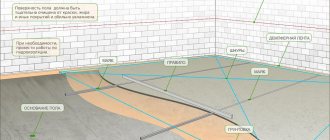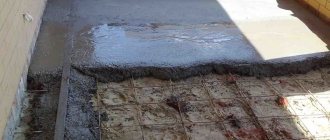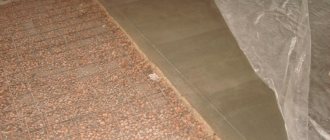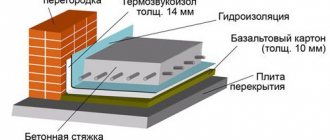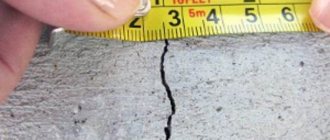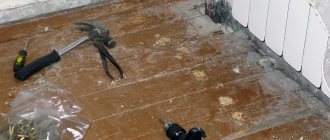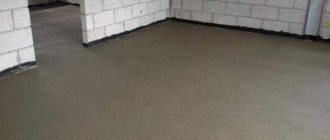A floor screed using expanded clay is needed to raise the floor level by 1-1.5 cm. This technique is used when it is necessary to bring the floors to the same level in all rooms. When mixing expanded clay with sand concrete, the proportions must be observed. Expanded clay concrete mortar is used for the following types of surface:
- horizontal;
- internal;
- external;
- inclined;
- residential;
- production.
Before starting construction work on pouring the floor, the thickness of the expanded clay and sand concrete layer is calculated, and the load that will affect the floor should be taken into account. If the task is set, insulate the floors on the first floors of the building or in rooms located above the room without heating. It is recommended to make a layer of expanded clay at least 10 centimeters. Otherwise, reliable thermal insulation will not work. To install a thin screed 6 cm thick, you will need 21 bags of sand concrete and 12 bags of expanded clay.
Advantages of expanded clay concrete screed
- increased thermal insulation qualities;
- high level of sound insulation;
- environmentally friendly building material does not have a negative impact on human health;
- the finished structure has a high margin of safety;
- the material is resistant to fungi and mold;
- long service life;
- no crack formation due to temperature changes;
- filling work will not be difficult;
- it is possible to level an uneven base;
- excellent combination with different types of coatings;
- light weight;
- fire resistance;
- resistance to the influence of chemical compounds;
- moisture resistance.
The above advantages make it possible to form a high-quality coating, which is intended for long-term use and installation of various types of finishing building materials for the floor.
Advantages and disadvantages of the method
Expanded clay-cement screed is the main layer that is located above the base. Expanded clay concrete for flooring is used taking into account the type of room, the general condition of the house and the future finishing coating.
Expanded clay has been popular for a very long time, and at the same time it does not lose its relevance as an additive in screeds today. Mixtures that can be purchased at construction stores do not lose quality for a long time. The material itself is made from clay, which is purified from various impurities. Granules are formed from the liquid composition under the influence of elevated temperatures.
Before you make a screed from expanded clay concrete with your own hands, you need to know what the advantages of this technology are. The main advantage is the following:
- In old structures and houses with wooden flooring, even with minor pouring, the base may not withstand the load of cement mortar. In this case, loose floors reduce the possibility of damage to the coating.
- This screed makes it possible to significantly increase the height. In cases where it is necessary to raise the level to a greater height due to unevenness of the base or to reduce the distance between the ceiling and floor, it is irrational to make a thick concrete layer.
- In cold regions, the main advantage is the frost resistance of expanded clay.
- Even strong differences in heights, cracks and holes can be filled with this composition and get a smooth expanded clay concrete floor screed.
- The material is durable - does not rot, is not flammable and is not susceptible to corrosion.
- Safety of use is also explained by its resistance to heat.
- Despite its natural origin, expanded clay screed is not susceptible to fungi, pathogenic organisms, rodents and mold.
- The environmental properties of the coating require good air and vapor permeability.
- The pouring technology makes it possible for even an inexperienced person to cope with this work. Handling the solution is quite simple.
- Due to its low weight, expanded clay can be easily transported even in large volumes.
- If you need high-quality sound insulation, then you should choose expanded clay. Moreover, unlike polystyrene foam or expanded polystyrene, it has low thermal conductivity and high strength.
- Expanded clay is moisture resistant. Water absorption is about 25%. This means that during flooding it is not subject to deformation for a long time.
At the same time, expanded clay screed has few disadvantages. The main disadvantages are as follows:
- To retain heat, it is not advisable to use small granules, just like a small layer of screed. It is required to increase the height by at least 15 cm.
- Do not allow the same granule size during dry screeding. Different sizes can give better uniformity and strength.
- If you are performing dry backfilling, then it is necessary to protect the base from moisture. Water will not be able to absorb, thereby creating mold and mildew in the house.
Proportions of constituent elements
What ratio of cement and sand and expanded clay will be needed for the screed? Calculations are made according to the following scheme:
- If the thickness of the expanded clay layer is 10 cm, then you will need 1.5 m3 per 15 m2.
- The required amount of sand concrete material is calculated according to the instructions indicated by the manufacturer on the packaging.
It is recommended to use ready-made mixtures of expanded clay and sand concrete to fill the screed; the building materials contain a balanced amount of components.
For any method of performing work, the following ingredients will be needed to prepare the mixture:
- Expanded clay in granules.
- Sand concrete.
- Water.
In order for the screed to turn out to be of high quality, you need to maintain the ratio of expanded clay and sand concrete. For example, to fill the foundation in a residential building, you need to mix expanded clay and sand concrete granules 1:1. When forming the classic version of the base, the thickness of which is 4 cm, you will need 52 kg of sand concrete and 45 kg of expanded clay.
Preparation of the solution
- A spacious container is filled with expanded clay.
- Add water.
- The granulated building material is mixed thoroughly, then wait until the water is absorbed.
- The remaining water that the expanded clay did not absorb is drained.
- Wet granules are loaded into a concrete mixer or left in a container.
- Add the required amount of sand concrete.
- Pour water into the resulting composition and stir until a homogeneous mass is obtained.
How long should you continue mixing the ingredients? Mixing is stopped when the expanded clay granules cease to stand out from the batch mass.
Laying expanded clay concrete mixture is carried out in different ways
- Wet. For this technique, you must first prepare a sand-cement composition, and then pour it onto a layer of expanded clay and distribute it evenly over the entire area.
- Semi-dry. Expanded clay granules are mixed with sand concrete and water, and then poured.
- Dry. The sand concrete solution is mixed with expanded clay and laid on the prepared base.
The choice of foundation formation technique will depend on the individual case. When technological recommendations are followed, each type of screed is allowed to form reliable foundations for the construction of the finishing layer.
Builders' recommendations
Builders note that dry screed results in a reliable and perfectly flat surface. In the future, the room with this finish retains heat well. Combined or wet screed does not cause significant problems during transportation and preparation of the mixture. The combined method makes it easier for two people to work together to prepare the mixture and pour the top layer. The floor can be made warm and durable with a layer of only 15 cm.
Finishers recommend spraying it with water from time to time while drying this coating so that the cement base does not crack when drying, and to prevent drafts in the apartment.
In new buildings, expanded clay floors are very popular, since there are no problems with transportation and delivery of materials to the upper floors.
Wet method
The mixture will be made using expanded clay, the ratio will be 2:1. It should turn out that for a volume of expanded clay of 80 cm3 you will need 80 bags and 0.4 m3 of dry composition - 21 bags of sand concrete. It is recommended to take a large container for kneading.
Work progress:
- Determination of differences in the height of the base, and determination of the maximum submerged area.
- Expanded clay is poured in and distributed evenly.
- Expanded clay granules are impregnated with a solution of cement laitance.
- The sand concrete solution is poured and leveled; it is recommended to start from a remote area of the room and then move to the exit.
- Next, you will need to maintain favorable humidity conditions by periodically moistening the surface layer.
Do not expose a massive structure to mechanical stress for the first 24 hours; it is strictly not recommended. When the milk has hardened, you can begin further repair work. Qualified builders advise protecting the formed surface from mechanical damage for 4 weeks from the moment of pouring.
Semi-dry method
The peculiarity of the method, which can provide a reduction in work time, is that expanded clay is added directly to the sand concrete solution.
Work progress:
- The concrete mixer is filled with expanded clay, then water is added so that the material absorbs it.
- Sand concrete is added and the ingredients are mixed until a homogeneous mass is obtained.
- Reinforcement is made with mesh.
- Fill the working surface with the prepared solution. The hardening surface should be periodically moistened and protected from shifting.
The semi-dry method technique requires the installation of a concrete base under a layer of expanded clay. It is easy to install and allows you to form the screed in layers using existing volumes of working composition. The consumption of materials will be 1:1, take 60 cm3 of expanded clay - 12 bags, plus 60 cm3 of sand concrete solution - 27-31 bags, 20 m2 of mesh for reinforcement. The dry type of screed for the base is made without the use of cement mortar.
How long will the material harden?
Floors made of sand concrete and expanded clay will harden over varying lengths of time depending on the influence of such factors:
- Ambient temperature.
- The thickness of the screed made.
- Moisture concentration in solution.
- Circulation of air flows in the room.
It is recommended to correct uneven surfaces no earlier than 24 hours after the floor has been poured. When the moisture has completely evaporated and the screed has acquired operational strength, you can cut the seams using special tools.
Hardening time of building material
How long your screed will take to cure is determined by a number of different factors. Among them:
- temperature regime;
- screed thickness;
- moisture saturation;
- air circulation, etc.
Moreover, operational irregularities (even the smallest defect) are eliminated in at least a day. Until the strength capability of the product has reached its peak, the use of any leveling tool is prohibited.
Be careful! Follow the instructions that manufacturers provide with their products, and also study articles from our website. All special publications on the blog allow you to calculate the optimal consumption, correctly implement the batch, and also roughly understand what amount of money will be spent during construction and repairs.
Calculation of expanded clay and sand concrete for screed per 1 sq.m
Let’s take, for example, Rusean sand concrete and expanded clay consumption per 1 m2. If you know the proportions of building materials per 1 square meter, calculating the specific dimensions of the room will not be difficult. Calculations of the volumes of required materials are made as follows:
- Let’s take a layer of screed equal to one centimeter; sand concrete per 1m2 will require 18 kg. If the volume of the floor is 100 m2, and the screed layer is 5 cm high, then the calculation is as follows: 18 kg x 100 m2 x 5.
- expanded clay is calculated in the same way. For a room of 12 m2 and a layer of expanded clay 10 cm thick, you will need 1.2 m3 of building material - 16 m2 x 0.1 m.
Composition of expanded clay concrete
This building material contains the following components: cement, sand, water, expanded clay.
Table of proportions of materials in the manufacture of expanded clay concrete.
Expanded clay concrete for screed can act as gravel, crushed stone or sand. The granules are oval in shape and medium in size. Crushed stone is multifaceted pieces of large sizes with sharp corners. Expanded clay sand is obtained by splitting large pieces of material into small ones.
Gravel is used to screed the expanded clay concrete floor. The proportions for the screed in the classic version are as follows:
- cement 1 part,
- water 1 part,
- sand 3 parts,
- expanded clay 2 parts.
After pouring the expanded clay concrete floor, the surface will need to be treated with a finishing screed. This is necessary in order to level the floor.
The proportions for screeding a floor made of expanded clay concrete depend on the pouring method: dry or wet. The ratio of various components allows you to obtain a solution of different brands.
To obtain expanded clay concrete grade M150, the proportions of cement, sand and expanded clay should be 1: 3.5: 5.7. The proportions of these elements for the M300 brand will be 1:1.9:3.7, for the M400 brand 1:1.2:2.7.
For 1 sq.m of screed 3 cm thick you will need 16 kg of cement and 50 kg of sand.
Return to contents
How to properly screed a floor with expanded clay
The composition of the solution will be of the class of lightweight concrete, namely expanded clay concrete. Sand concrete M 300 and expanded clay will have the following proportions when preparing 1 m3:
- 20-25 bags of expanded clay of various fractions. The volume will be 0.7 m3;
- 12-14 bags of sand concrete, 50 kg each, grade M 300.
How much sand concrete is needed for expanded clay. More cement in the composition will add strength to the structure and increase thermal conductivity. In order to increase the thermal insulation qualities, it is recommended to use less cement. Private builders advise using the optimal ratio - 2 bags of expanded clay granules per 50 kg bag of sand concrete.
